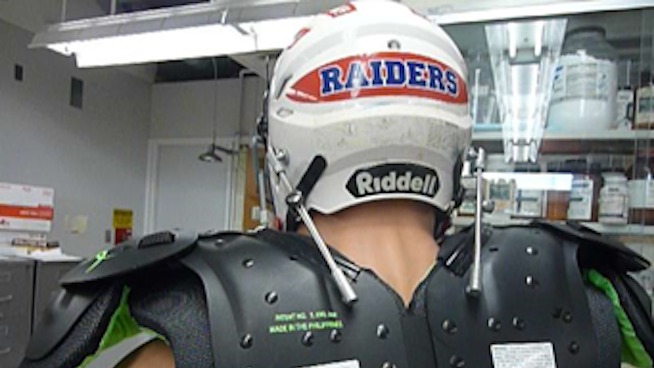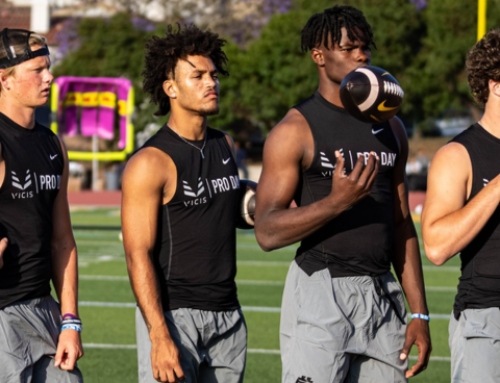Could This Futuristic Football Helmet Stem the Concussion Epidemic?
Chiming Huang had a theory.
In 2012, as a part of a graduate research project, Huang and a few colleagues were attempting to understand the effects that traumatic brain injuries (TBIs) had on the thousands of soldiers returning home from combat in the Middle East. As his team focused on what Huang called the “hurt brain and how to fix it,” Huang’s own brain was going full Minority Report.
What if we could prevent concussions before they ever happened?
Huang, who earned degrees in both neuroscience and engineering, based his hypothesis on a basic principle of physics. “When a force strikes you or any other material, the energy of that force travels through the medium at the speed of sound,” Huang said. “But today, we have technology that processes information at the speed of light. So it seemed to me that to neutralize a force, to dissipate a force after the effect is not entirely out of the question. So that was my first thought, back in 2012.”
By 2014, Huang’s gaze turned toward a field that desperately needed his theory to be true: football.
RELATED: The 100-Year-Old Concussion Technique That’s Making a Comeback
The NFL is slogging through a dismal 2016 season, with declining television ratings week after week, including last week’s Seahawks-Cardinals Sunday Night Football matchup, which was down a whopping 14 percent in viewership compared to last year’s equivalent. There are many reasons for the disinterest, including a stark dip in the quality of play. The aforementioned Seahawks-Cardinals game ended in a 6-6 tie after both teams’ field goal kickers missed chip shots in overtime. That’s an abomination.
Injuries have played a huge role in the NFL’s quality problem, especially concussions. In 2015, according to the league’s own statistics, diagnosed concussions were up a ridiculous 32 percent from the previous season. And with the discovery of chronic traumatic encephalopathy (CTE) and the growing understanding of the terrifying effects of head injuries later in life, participation in youth football is down, too, sinking 5.8 percent from 2008 to 2014 with kids ages 6 to 18, according to the Wall Street Journal. The NFL, and football in general, is in a perilous place.
Huang, now an associate professor of biological sciences at the University of Missouri-Kansas City and the founder of SedouSkull, the organization behind his research, wants to save football from itself by creating a helmet that absorbs force to the head, then dissipates its impact energy down to the rest of the body, therefore reducing said impact to the head. To do so, Huang turned away from the “drop test” that has been used to test major manufacturers’ helmet safety ratings for years.
“The drop test, which is still in use and is the most widely used helmet test today, doesn’t treat the whole head collision fairly,” Huang said. “We like to think about this as a multi-body problem. When you get hit, your head bends back first, and then, when it cannot bend anymore, it drags the rest of your body with it. So part of the impact force goes to your body. If you can make more of the force go into your body, then your head would be better off.”

Huang came up with the concept of what he calls an “active” helmet, and it works like this: when a force is applied to the head, sensors inside the helmet alert what Huang refers to as the “linkage elements,” two rods that run from the sides of the back of the helmet into the shoulder pads, to go rigid. That rigidity creates a pathway for the impact energy to disperse itself down into the shoulder pads and over the rest of the body, greatly reducing the impact to the head and preventing a concussion.
RELATED: A New Study Says Football Practices Without Helmets Reduces Concussion Risk and Improves Tackling
“The physics of that is no different than the the flow of electricity in a circuit board when you have resistance in parallel or in a series,” Huang said. “It’s the same thing here. We create and provide an impedance matched pathway for the energy and it will preferentially go down the shoulder pads.”
At the moment, the active helmet is geared toward youth football players, the breeding ground for high school, college and eventually professional teams. Huang is targeting kids for two reasons: One, kids don’t hit as hard, making it easier to channel the impact energy down into the rest of their bodies, and two, a concussion can be incredibly detrimental to a child whose brain is still developing.
Huang and his crew hope to have the helmet sensors and linkage elements to market by June of 2017. They will be beta testing the active helmet with a local Kansas City youth team before next year’s season begins.
Huang’s helmet may ease the fears of parents who no longer view football as a sport they want their child to play and even help populate youth football with the increasing numbers it needs; but the decision that comes with it, choosing to accept force to either your head or your body, may forever be football’s unsolvable puzzle, its fatal flaw.
“When you get hit with a lot of force, there aren’t too many good options,” Huang said. “You can tell yourself, ‘OK, I want to put all the energy to my head, I want to save my body,’ or you can say, ‘My head is more important, I need to channel the force to my body, I think my shoulder can take it.’ That’s the decision that you have to make.”
It’s a decision that could ultimately lead to football’s extinction.
RECOMMENDED FOR YOU
Could This Futuristic Football Helmet Stem the Concussion Epidemic?
Chiming Huang had a theory.
In 2012, as a part of a graduate research project, Huang and a few colleagues were attempting to understand the effects that traumatic brain injuries (TBIs) had on the thousands of soldiers returning home from combat in the Middle East. As his team focused on what Huang called the “hurt brain and how to fix it,” Huang’s own brain was going full Minority Report.
What if we could prevent concussions before they ever happened?
Huang, who earned degrees in both neuroscience and engineering, based his hypothesis on a basic principle of physics. “When a force strikes you or any other material, the energy of that force travels through the medium at the speed of sound,” Huang said. “But today, we have technology that processes information at the speed of light. So it seemed to me that to neutralize a force, to dissipate a force after the effect is not entirely out of the question. So that was my first thought, back in 2012.”
By 2014, Huang’s gaze turned toward a field that desperately needed his theory to be true: football.
RELATED: The 100-Year-Old Concussion Technique That’s Making a Comeback
The NFL is slogging through a dismal 2016 season, with declining television ratings week after week, including last week’s Seahawks-Cardinals Sunday Night Football matchup, which was down a whopping 14 percent in viewership compared to last year’s equivalent. There are many reasons for the disinterest, including a stark dip in the quality of play. The aforementioned Seahawks-Cardinals game ended in a 6-6 tie after both teams’ field goal kickers missed chip shots in overtime. That’s an abomination.
Injuries have played a huge role in the NFL’s quality problem, especially concussions. In 2015, according to the league’s own statistics, diagnosed concussions were up a ridiculous 32 percent from the previous season. And with the discovery of chronic traumatic encephalopathy (CTE) and the growing understanding of the terrifying effects of head injuries later in life, participation in youth football is down, too, sinking 5.8 percent from 2008 to 2014 with kids ages 6 to 18, according to the Wall Street Journal. The NFL, and football in general, is in a perilous place.
Huang, now an associate professor of biological sciences at the University of Missouri-Kansas City and the founder of SedouSkull, the organization behind his research, wants to save football from itself by creating a helmet that absorbs force to the head, then dissipates its impact energy down to the rest of the body, therefore reducing said impact to the head. To do so, Huang turned away from the “drop test” that has been used to test major manufacturers’ helmet safety ratings for years.
“The drop test, which is still in use and is the most widely used helmet test today, doesn’t treat the whole head collision fairly,” Huang said. “We like to think about this as a multi-body problem. When you get hit, your head bends back first, and then, when it cannot bend anymore, it drags the rest of your body with it. So part of the impact force goes to your body. If you can make more of the force go into your body, then your head would be better off.”

Huang came up with the concept of what he calls an “active” helmet, and it works like this: when a force is applied to the head, sensors inside the helmet alert what Huang refers to as the “linkage elements,” two rods that run from the sides of the back of the helmet into the shoulder pads, to go rigid. That rigidity creates a pathway for the impact energy to disperse itself down into the shoulder pads and over the rest of the body, greatly reducing the impact to the head and preventing a concussion.
RELATED: A New Study Says Football Practices Without Helmets Reduces Concussion Risk and Improves Tackling
“The physics of that is no different than the the flow of electricity in a circuit board when you have resistance in parallel or in a series,” Huang said. “It’s the same thing here. We create and provide an impedance matched pathway for the energy and it will preferentially go down the shoulder pads.”
At the moment, the active helmet is geared toward youth football players, the breeding ground for high school, college and eventually professional teams. Huang is targeting kids for two reasons: One, kids don’t hit as hard, making it easier to channel the impact energy down into the rest of their bodies, and two, a concussion can be incredibly detrimental to a child whose brain is still developing.
Huang and his crew hope to have the helmet sensors and linkage elements to market by June of 2017. They will be beta testing the active helmet with a local Kansas City youth team before next year’s season begins.
Huang’s helmet may ease the fears of parents who no longer view football as a sport they want their child to play and even help populate youth football with the increasing numbers it needs; but the decision that comes with it, choosing to accept force to either your head or your body, may forever be football’s unsolvable puzzle, its fatal flaw.
“When you get hit with a lot of force, there aren’t too many good options,” Huang said. “You can tell yourself, ‘OK, I want to put all the energy to my head, I want to save my body,’ or you can say, ‘My head is more important, I need to channel the force to my body, I think my shoulder can take it.’ That’s the decision that you have to make.”
It’s a decision that could ultimately lead to football’s extinction.










